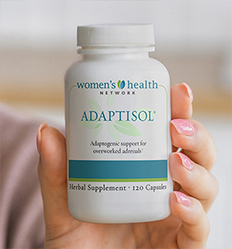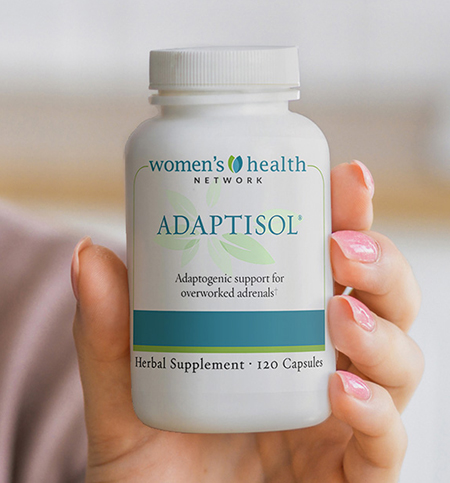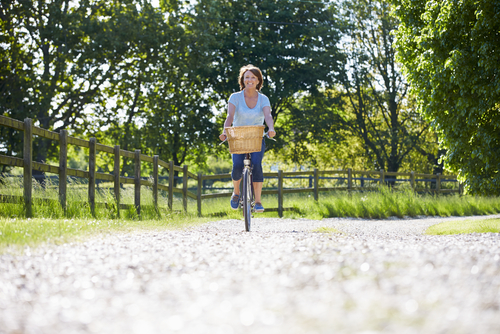Reviewed by Dr. Mary James, ND
Lack of energy in women is so common that many of us think it’s just part of getting older. Well, it’s not. If you are experiencing low energy levels and debilitating fatigue, the first step is to pinpoint the cause so you can find ways to boost your energy and get relief.
Adrenal fatigue — that is, an imbalance in adrenal stress hormone production from unrelenting stress — can cause different symptoms from person to person depending on their physiology and individual circumstances.
To start uncovering the true source of your low energy and fatigue, a good first step is to investigate your adrenal function. Often overlooked by conventional medicine as a source of fatigue, the adrenal glands drive and manage your body’s reactions and responses to stress. And because stress comes in many forms — real and perceived, physical and emotional — your adrenal glands may have been working overtime for many months or even years.
When stress is unrelenting — even the non-emergency type like a problem at work or a traffic jam — your adrenals can stay on alert indefinitely and stress hormone production remains ramped up. As a result, adrenal hormones, especially cortisol, can be pushed out of balance, leading to symptoms including extreme lack of energy, crushing fatigue and more.
Top 5 natural ingredients for an energy boost
It’s not unusual for women to rely on caffeine or other stimulants to jump start their day, but doing that simply covers up (instead of solving) the problem. Fortunately, there are natural ways to boost your energy, such as herbs that help relieve adrenal stress and lack of energy — these work with your body to restore balance, rather than just masking symptoms.
Astragalus root (A. membranaceus)
Aids in the body’s natural ability to adapt to stress, bolstering the immune system so that you stay well. Also helps to regulate normal blood sugar levels and alleviate insulin resistance.
Cordyceps (C. sinensis)
As an antioxidant, it can slow aging and take the load off the adrenals by supporting the immune system, balancing the inflammatory response and helping to stabilize blood sugar.
Eleuthero (Eleutherococcus senticosus, formerly called Siberian ginseng)
An adaptogenic herb that can help protect against the negative effects of stress, while decreasing fatigue, enhancing mental clarity and helping to balance blood sugar.
Rhodiola rosea (“golden root”)
An adaptogenic herb that protects against stress-related fatigue and “burnout.” It also increases mental clarity and offers immune and blood sugar support. Added benefits of Rhodiola are its antidepressant and anti-anxiety properties.
Licorice root (Glycyrrhiza glabra)
Well known for supporting adrenal balance, licorice root aids in increasing energy and endurance. As certain forms of licorice can increase blood pressure and lower potassium, this herb is best taken under the care of an herbalist or a functional medicine practitioner.
Depending on your symptoms, you may need therapy that’s more stimulating, or one that’s more relaxing, or even a little of both. You can talk with an experienced herbalist, naturopath or functional medicine practitioner about your symptoms, working together to find the right combination of herbs for your unique needs.
How to increase your energy naturally
- Plan to get at least 7-8 hours of sleep each night. Be in bed and sleeping by 10:00 or 10:30 PM at the latest. If you need to unwind, or it takes you a little bit to fall asleep, then get to bed at 9:00 or 9:30 PM. Try these doctor-approved sleep secrets to help you get the restorative sleep you need.
- Modify your workout. Choose forms of physical exercise that calm you down instead of rev you up. Walking, yoga, Tai Chi and other forms of low impact exercise are easy ways to boost your energy levels. They also work wonders for adrenal imbalance by “sopping up” excess cortisol circulating in your system, helping you feel more relaxed and allowing the adrenals to rest. On the other hand, high intensity exercise can trigger cortisol production. Listen to your body. If a certain form of exercise makes your energy levels drop even more, move on and try something else.
- Eat well and often. The goal is to achieve more stable energy levels throughout the day, which you can accomplish by eating three balanced meals with two snacks. What you eat does make a difference too! Try to reduce refined carbohydrates such as sugar, flour, potatoes and white rice which cause stressful ups and downs in your blood sugar that can lead to adrenal imbalance.
- Learn to play. Take time to understand where your stress is coming from, and then think about how you’ll make changes that are right for you and your lifestyle. Get used to saying “no” more often to all those extraneous requests (the school bake sale can still be a success without you!) and make more time for activities that nourish your soul and lift your energy levels. You know you’re on the right track when at least part of your day feels more like play!
How to get your energy back — naturally
In a world where women are expected to do more and more — and do it perfectly —it’s difficult to step back and take a breath. But you don’t really have to do it all, nor do you have to feel exhausted every day. And you can find this balance without relying on sugar, carbs, and caffeine to make it through from one hour to the next. You have choices for adrenal support that can boost your energy naturally, prevent further health issues, and put you on the path to good adrenal health.
References
1 Caffeine Awareness Alliance. 2006. Caffeine and the adrenal glands. URL: https://www.caffeineawareness.org/forum/adrenal_glands.html (accessed 07.21.2009).
Lovallo, W., et al. 2005. Caffeine stimulation of cortisol secretion across the waking hours in relation to caffeine intake levels. Psychosom. Med., 67 (5), 734–739. URL: https://www.psychosomaticmedicine.org/cgi/content/full/67/5/734 (accessed 08.11.2009).
2 Wilson, J. 2001. Adrenal Fatigue: The 21st Century Syndrome., 156. Petaluma, CA: Smart Publications.
3 [No author listed.] 2005. Eleutherococcus senticosus monograph. Altern. Med. Rev., 11 (2), 151-155.URL (PDF): https://www.thorne.com/altmedrev/.fulltext/11/2/151.pdf (accessed 07.24.2009).
4 Panossian, A., et al. 2009. Adaptogens exert a stress-protective effect by modulation of expression of molecular chaperones. Phytomedicine, 16 (6–7), 617–622. URL (abstract): https://www.ncbi.nlm.nih.gov/pubmed/19188053 (accessed 03.12.2009).
5 Gaffney, B., et al. 2001. Panax ginseng and Eleutherococcus senticosus may exaggerate an already existing biphasic response to stress via inhibition of enzymes which limit the binding of stress hormones to their receptors. Med. Hypotheses, 56 (5), 567–572. URL (abstract): https://www.ncbi.nlm.nih.gov/pubmed/11388770 (accessed 03.12.2009).
6 Roxas, M., & Jurenka, J. 2007. Colds and influenza: A review of diagnosis and conventional, botanical, and nutritional considerations. Altern. Med. Rev., 12 (1), 25-48. Review. URL (PDF): https://www.thorne.com/altmedrev/.fulltext/12/1/25.pdf (accessed 03.12.2009).
[No author listed.] 2006. Monograph. Eleutherococcus senticosus. Altern. Med. Rev, 11 (2), 151–155. URL (PDF): https://www.thorne.com/altmedrev/.fulltext/11/2/151.pdf (accessed 03.12.2009).
Narimanian, M., et al. 2005. Impact of Chisan (ADAPT-232) on the quality-of-life and its efficacy as an adjuvant in the treatment of acute non-specific pneumonia. Phytomedicine, 12 (10), 723–729. URL: https://www.ncbi.nlm.nih.gov/pubmed/16323290 (accessed 03.12.2009).
Narimanian, M., et al. 2005. Randomized trial of a fixed combination (Kan Jang) of herbal extracts containing Adhatoda vasica, Echinacea purpurea and Eleutherococcus senticosus in patients with upper respiratory tract infections. Phytomedicine, 12 (8), 539–547. URL (abstract): https://www.ncbi.nlm.nih.gov/pubmed/16121513 (accessed 03.12.2009).
7 Chen, T., et al. 2008. Antioxidant evaluation of three adaptogenic extracts. Am. J. Chin. Med., 36 (6), 1209–1217. URL (abstract): https://www.ncbi.nlm.nih.gov/pubmed/19051347 (accessed 03.12.2009).
Jung, C., et al. 2007. Eleutherococcus senticosus extract attenuates LPS-induced iNOS expression through the inhibition of Akt and JNK pathways in murine macrophage. J. Ethnopharmacol., 113 (1), 183–187. URL (abstract): https://www.ncbi.nlm.nih.gov/pubmed/17644291 (accessed 03.12.2009).
8 Bocharov, E., et al. 2008. [Neuroprotective features of phytoadaptogens.] Vestn. Ross. Akad. Med. Nauk. (4), 47–50. URL (abstract): https://www.ncbi.nlm.nih.gov/pubmed/18488457 (accessed 03.12.2009).
Soya, H., et al. 2008. Extract from Acanthopanax senticosus Harms (Siberian ginseng) activates NTS and SON/PVN in the rat brain. Biosci. Biotechnol. Biochem., 72 (9), 2476-2480. URL: https://www.jstage.jst.go.jp/article/bbb/72/9/72_2476/_article (accessed 03.12.2009).
Narimanian, M., et al. 2005. Impact of Chisan (ADAPT-232) on the quality-of-life and its efficacy as an adjuvant in the treatment of acute non-specific pneumonia. Phytomedicine, 12 (10), 723–729. URL: https://www.ncbi.nlm.nih.gov/pubmed/16323290 (accessed 03.12.2009).
Narimanian, M., et al. 2005. Randomized trial of a fixed combination (Kan Jang) of herbal extracts containing Adhatoda vasica, Echinacea purpurea and Eleutherococcus senticosus in patients with upper respiratory tract infections. Phytomedicine, 12 (8), 539–547. URL (abstract): https://www.ncbi.nlm.nih.gov/pubmed/16121513 (accessed 03.12.2009).
Panossian, A., & Wagner, H. 2005. Stimulating effect of adaptogens: An overview with particular reference to their efficacy following single-dose administration. Phytother. Res., 19 (10), 819–838. URL (abstract): https://www.ncbi.nlm.nih.gov/pubmed/16261511 (accessed 03.12.2009).
Arushanian, E., et al. 2003. [Effect of Eleutherococcus on short-term memory and visual perception in healthy humans.] Eskp. Klin. Farmakol., 66 (5), 10–13. URL (abstract): https://www.ncbi.nlm.nih.gov/pubmed/14650206 (accessed 03.12.2009).
9 Liu, K., et al. 2008. Release of acetylcholine by syringin, an active principle of Eleutherococcus senticosus, to raise insulin secretion in Wistar rats. Neurosci. Lett., 434 (2), 195–199. URL (abstract): https://www.ncbi.nlm.nih.gov/pubmed/18304730 (accessed 03.12.2009).
Niu, H., et al. 2008. Hypoglycemic effect of syringin from Eleutherococcus senticosus in streptozotocin-induced diabetic rats. Planta Med., 74 (2), 109-113. URL (abstract): https://www.ncbi.nlm.nih.gov/pubmed/18203055 (accessed 03.12.2009).
10 Hwang, Y., et al. 2009. The effects of Acanthopanax senticosus extract on bone turnover and bone mineral density in Korean postmenopausal women. J. Bone Miner. Metab. [Epub ahead of print.] URL (abstract): https://www.ncbi.nlm.nih.gov/pubmed/19452124 (accessed 05.26.2009).
11 Kuo, Y., et al. 2009. Astragalus membranaceus flavonoids (AMF) ameliorate chronic fatigue syndrome induced by food intake restriction plus forced swimming. J. Ethnopharmacol., 122 (1), 28–34. URL (abstract): https://www.ncbi.nlm.nih.gov/pubmed/19103273 (accessed 03.10.2009).
Cho, W., & Leung, K. 2007. In vitro and in vivo immunomodulating and immunorestorative effects of Astragalus membranaceus. J. Ethnopharmacol., 113 (1), 132–141. URL (abstract): https://www.ncbi.nlm.nih.gov/pubmed/17611061 (accessed 03.12.2009).
12 Wang, S., et al. 2009. Anti-hepatitis B virus activities of astragaloside IV isolated from radix Astragali. Biol. Pharm. Bull., 32 (1), 132-135. URL: https://www.jstage.jst.go.jp/article/bpb/32/1/32_132/_article (accessed 03.10.2009).
Du, Q., et al. 2008. Inhibitory effects of astragaloside IV on ovalbumin-induced chronic experimental asthma. Can. J. Physiol. Pharmacol., 86 (7), 449–457. URL (abstract): https://www.ncbi.nlm.nih.gov/pubmed/18641694 (accessed 03.10.2009).
Li, R., et al. 2008. [Immunomodulatory effects of Astragalus polysaccharide in diabetic mice.] Zhong Xi Yi Jie He Xue Bao, 6 (2), 166–170. URL (PDF): https://www.jcimjournal.com/articles/publishArticles/pdf/20082261195.pdf (accessed 03.12.2009).
Ryu, M., et al. 2008. Astragali Radix elicits anti-inflammation via activation of MKP-1, concomitant with attenuation of p38 and Erk. J. Ethnopharmacol., 115 (2), 184–193. URL (abstract): https://www.ncbi.nlm.nih.gov/pubmed/17996413 (accessed 03.12.2009).
Shen, H., et al. 2008. Astragalus membranaceus prevents airway hyperreactivity in mice related to Th2 response inhibition. J. Ethnopharmacol., 116 (2), 363–369. URL (abstract): https://www.ncbi.nlm.nih.gov/pubmed/18226482 (accessed 03.12.2009).
Sun, W., et al. 2008. Protective effect of extract from Paeonia lactiflora and Astragalus membranaceus against liver injury induced by bacillus Calmette–Guérin and lipopolysaccharide in mice. Basic Clin. Pharmacol. Toxicol., 103 (2), 143–149. URL (abstract): https://www.ncbi.nlm.nih.gov/pubmed/18816297 (accessed 03.12.2009).
Cho, W., & Leung, K. 2007. In vitro and in vivo immunomodulating and immunorestorative effects of Astragalus membranaceus. J. Ethnopharmacol., 113 (1), 132–141. URL (abstract): https://www.ncbi.nlm.nih.gov/pubmed/17611061 (accessed 03.12.2009).
Hu, J., et al. 2007. [Protective effects of Astragaloside and Quercetin on rat myocardial cells after hypoxia.] Zhonghua Shao Shang Za Zhi, 23 (3), 175–178. URL (abstract): https://www.ncbi.nlm.nih.gov/pubmed/18019054 (accessed 03.10.2009).
Roxas, M., & Jurenka, J. 2007. Colds and influenza: A review of diagnosis and conventional, botanical, and nutritional considerations. Altern. Med. Rev., 12 (1), 25-48. Review. URL (PDF): https://www.thorne.com/altmedrev/.fulltext/12/1/25.pdf (accessed 03.12.2009).
Xu, H., et al. 2007. Effects of Astragalus polysaccharides and astragalosides on the phagocytosis of Mycobacterium tuberculosis by macrophages. J. Int. Med. Res., 35 (1), 84–90. URL (abstract): https://www.ncbi.nlm.nih.gov/pubmed/17408058 (accessed 03.10.2009).
13 Mao, X., et al. 2009. Hypoglycemic effect of polysaccharide enriched extract of Astragalus membranaceus in diet induced insulin resistant C57BL/6J mice and its potential mechanism. Phytomedicine. [Epub ahead of print.] URL (abstract): https://www.ncbi.nlm.nih.gov/pubmed/19201177 (accessed 03.10.2009).
Xu, A., et al. 2009. Selective elevation of adiponectin production by the natural compounds derived from a medicinal herb alleviates insulin resistance and glucose intolerance in obese mice. Endocrinology, 150 (2), 625–633. URL (abstract): https://www.ncbi.nlm.nih.gov/pubmed/18927219 (accessed 03.10.2009).
Jiang, B., et al. 2008. Astragaloside IV attenuates lipolysis and improves insulin resistance induced by TNFalpha in 3T3-L1 adipocytes. Phytother. Res., 22 (11), 1434–1439. URL (abstract): https://www.ncbi.nlm.nih.gov/pubmed/18972582 (accessed 03.10.2009).
Li, R., et al. 2008. [Immunomodulatory effects of Astragalus polysaccharide in diabetic mice.] Zhong Xi Yi Jie He Xue Bao, 6 (2), 166–170. URL (PDF): https://www.jcimjournal.com/articles/publishArticles/pdf/20082261195.pdf (accessed 03.12.2009).
Peng, X., et al. 2008. [Regulatory effect of Astragalus membranaceus on the immune disorder in rats with IgA nephropathy.] Zhonghua Er Ke Za Zhi, 46 (1), 55–60. URL (abstract): https://www.ncbi.nlm.nih.gov/pubmed/18353241 (accessed 03.12.2009).
Yuan, W., et al. 2008. Astragaloside IV inhibits proliferation and promotes apoptosis in rat vascular smooth muscle cells under high glucose concentration in vitro. Planta Med., 74 (10), 1259–1264. URL (abstract): https://www.ncbi.nlm.nih.gov/pubmed/18622899 (accessed 03.10.2009).
Zhang, G., et al. 2008. [Effects of Astragalus on renal tubulointerstitial lesions and expression of NF-kappaB and MCP-1 in renal tissues in rat experimental IgA nephropathy.] Zhongguo Dang Dai Er Ke Za Zhi, 10 (2), 173–178. URL (abstract): https://www.ncbi.nlm.nih.gov/pubmed/18433541 (accessed 03.12.2009).
Li, R., et al. 2007. The immunotherapeutic effects of Astragaluspolysaccharide in type 1 diabetic mice. Biol. Pharm. Bull., 30 (3), 470–476. URL (PDF): https://www.jstage.jst.go.jp/article/bpb/30/3/470/_pdf (accessed 03.12.2009).
Ma, W., et al. 2007. Combined effects of fangchinoline from Stephania tetrandra Radix and formononetin and calycosin from Astragalus membranaceus Radix on hyperglycemia and hypoinsulinemia in streptozotocin-diabetic mice. Biol. Pharm. Bull., 30 (11), 2079–2083. URL (PDF): https://www.jstage.jst.go.jp/article/bpb/30/11/2079/_pdf (accessed 03.12.2009).
Zhang, Z., et al. 2007. [Effect of astragaloside on myocardial fibrosis in chronic myocarditis.] Zhongguo Zhong Xi Yi Jie He Za Zhi, 27 (8), 728–731. URL (abstract): https://www.ncbi.nlm.nih.gov/pubmed/17879539 (accessed 03.10.2009).
Zhang, Z., et al. 2007. Merit of Astragalus polysaccharide in the improvement of early diabetic nephropathy with an effect on mRNA expressions of NF-kappaB and IkappaB in renal cortex of streptozotoxin-induced diabetic rats. J. Ethnopharmacol., 114 (3), 387–392. URL (abstract): https://www.ncbi.nlm.nih.gov/pubmed/17900838 (accessed 03.12.2009).
Xu, M., et al. 2006. Effects of astragaloside IV on pathogenesis of metabolic syndrome in vitro. Acta Pharmacol. Sin., 27 (2), 229-236. URL: https://www.chinaphar.com/1671-4083/27/229.htm (accessed 03.10.2009).
14 Ji, D., et al. 2009. Antiaging effect of Cordyceps sinensis extract. Phyther. Res., 23 (1), 116–122. URL (abstract): https://www.ncbi.nlm.nih.gov/pubmed/18803231 (accessed 02.26.2009).
Ko, K., & Leung, H. 2007. Enhancement of ATP generation capacity, antioxidant activity and immunomodulatory activities by Chinese Yang and Yin tonifying herbs. Chin. Med., 2 (1), 3. URL: https://www.cmjournal.org/content/2/1/3 (accessed 08.12.2009).
Wang, Y., et al. 2004. [An experimental study on anti-aging action of Cordyceps extract.] Zhongguo Zhong Yao Za Zhi, 29 (8), 773-776. URL (abstract): https://www.ncbi.nlm.nih.gov/pubmed/15506292 (accessed 03.16.2009).
15 Zhou, X., et al. 2008. Cordycepin is an immunoregulatory active ingredient of Cordyceps sinensis. Am. J. Chin. Med., 36 (5), 967–980. URL (abstract): https://www.ncbi.nlm.nih.gov/pubmed/19051361 (accessed 02.26.2009).
Yoon, T., et al. 2008. Innate immune stimulation of exo-polymers prepared from Cordyceps sinensis by submerged culture. Appl. Microbiol. Biotechnol., 80 (6), 1087–1093. URL (abstract): https://www.ncbi.nlm.nih.gov/pubmed/18690428 (accessed 02.26.2009).
Zhou, X., et al. 2008. Cordycepin is an immunoregulatory active ingredient of Cordyceps sinensis. Am. J. Chin. Med., 36 (5), 967–980. URL (abstract): https://www.ncbi.nlm.nih.gov/pubmed/19051361 (accessed 02.26.2009).
16 Li, C., et al. 2009. Two-sided effect of Cordyceps sinensis on dendritic cells in different physiological stages. J. Leukoc. Biol., 85. [Epub ahead of print.] URL (PDF): https://www.jleukbio.org/cgi/rapidpdf/jlb.0908573v1 (accessed 03.16.2009).
17 Park, D., et al. 2008. Immunoglobulin and cytokine production from mesenteric lymph node lymphocytes is regulated by extracts of Cordyceps sinensis in C57BI/6N mice. J. Med. Food, 11 (4), 784–787. URL (abstract): https://www.ncbi.nlm.nih.gov/pubmed/19053874 (accessed 02.26.2009).
Kuo, M., et al. 2007. Immunomodulatory effect of exo-polysaccharides from submerged cultured Cordyceps sinensis: Enhancement of cytokine synthesis, CD11b expression, and phagocytosis. Appl. Microbiol. Biotechnol., 75 (4), 769-775. URL (abstract): https://www.ncbi.nlm.nih.gov/pubmed/17310399 (accessed 03.16.2009).
18 Li, C., et al. 2009. Two-sided effect of Cordyceps sinensis on dendritic cells in different physiological stages. J. Leukoc. Biol., 85. [Epub ahead of print.] URL (PDF): https://www.jleukbio.org/cgi/rapidpdf/jlb.0908573v1 (accessed 03.16.2009).
Zhou, X., et al. 2009. Cordyceps fungi: Natural products, pharmacological functions and developmental products. J. Pharm. Pharmacol., 61 (3), 279-291. URL (abstract): https://www.ncbi.nlm.nih.gov/pubmed/19222900 (accessed 02.26.2009).
Li, S., et al. 2006. Hypoglycemic activity of polysaccharide, with antioxidation, isolated from cultured Cordyceps mycelia. Phytomedicine, 13 (6), 428-433. URL (abstract): https://www.ncbi.nlm.nih.gov/pubmed/16716913 (accessed 03.16.2009).
Lo, H., et al. 2006. Anti-hyperglycemic activity of natural and fermented Cordyceps sinensis in rats with diabetes induced by nicotinamide and streptozotocin. Am. J. Chin Med., 34 (5), 819-832. URL (abstract): https://www.ncbi.nlm.nih.gov/pubmed/17080547 (accessed 03.16.2009).
19 Panossian, A., et al. 2009. Adaptogens exert a stress-protective effect by modulation of expression of molecular chaperones. Phytomedicine, 16 (6–7), 617–622. URL (abstract): https://www.ncbi.nlm.nih.gov/pubmed/19188053 (accessed 03.12.2009).
20 Panossian, A., et al. 2009.
21 Olsson, E., et al. 2009. A randomised, double-blind, placebo-controlled, parallel-group study of the standardised extract shr-5 of the roots of Rhodiola rosea in the treatment of subjects with stress-related fatigue. Planta Med., 75 (2), 105–112. URL (abstract): https://www.ncbi.nlm.nih.gov/pubmed/19016404 (accessed 03.13.2009).
22 [No author listed.] 2002. Rhodiola rosea. Monograph. Altern. Med. Rev., 7 (5), 421–423. URL (PDF): https://www.ncbi.nlm.nih.gov/pubmed/12659243 (accessed 03.16.2009).
Brown, R., et al. 2002. Rhodiola rosea: A phytomedicinal overview. HerbalGram, J. Am. Bot. Counc., 56, 40-52. URL: https://content.herbalgram.org/abc/herbalgram/articleview.asp?a=2333 (accessed 03.13.2009).
Darbinyan, V., et al. 2000. Rhodiola rosea in stress-induced fatigue — a double-blind cross-over study of a standardized extract SHR-5 with a repeated low-dose regimen on the mental performance of healthy physicians during night duty. Phytomedicine, 7 (5), 365–371. URL (abstract): https://www.ncbi.nlm.nih.gov/pubmed/11081987 (accessed 03.13.2009).
Spasov, A., et al. 2000. A double-blind, placebo-controlled pilot study of the stimulating and adaptogenic effect of Rhodiola rosea SHR-% extract on the fatigue of students caused by stress during an examination period with a repeated low-dose regimen. Phytomedicine, 7 (2), 85–89. URL (abstract): https://www.ncbi.nlm.nih.gov/pubmed/10839209 (accessed 08.12.2009).
23 Kwon Y., et al. 2006. Evaluation of Rhodiola crenulata and Rhodiola rosea for management of type II diabetes and hypertension. Asia Pac. J. Clin. Nutr., 15 (3), 425-432. URL (abstract): https://www.ncbi.nlm.nih.gov/pubmed/16837437 (accessed 03.13.2009).
24 Bystritsky, A., et al. 2008. A pilot study of Rhodiola rosea (Rhodax) for generalized anxiety disorder (GAD). J. Altern. Complement. Med., 14 (2), 175-180. URL (abstract): https://www.ncbi.nlm.nih.gov/pubmed/18307390 (accessed 03.13.2009).
Panossian, A., et al. 2008. Comparative study of Rhodiola preparations on behavioral despair of rats. Phytomedicine, 15 (1-2), 84-91. URL (abstract): https://www.ncbi.nlm.nih.gov/pubmed/18054474 (accessed 03.13.2009).
Qin, Y., et al. 2008. [Effects of Rhodiola rosea on level of 5-hydroxytryptamine, cell proliferation and differentiation, and number of neurons in cerebral hippocampus of rats with depression induced by chronic mild stress.] Zhongguo Zhong Yao Za Zhi, 33 (23), 2842–2846. URL (abstract): https://www.ncbi.nlm.nih.gov/pubmed/19260327 (accessed 03.13.2009).
Darbinyan, V., et al. 2007. Clinical trial of Rhodiola rosea L. extract SHR-5 in the treatment of mild to moderate depression. Nord. J. Psychiatry, 61 (5), 343-348. Erratum in: Nord. J. Psychiatry, 2007; 61 (6):503. URL (abstract): https://www.ncbi.nlm.nih.gov/pubmed/17990195 (accessed 03.13.2009).
25 Mumoli, N., & Cei, M. 2009. Licorice-induced hypokalemia. Int. J. Cardiol., 124 (3), e42–44. URL: https://www.ncbi.nlm.nih.gov/pubmed/17320224 (accessed 08.03.2009).
26 Shibata, S. 2000. A drug over the millennia: Pharmacognosy, chemistry, and pharmacology of licorice. Yakugaku Zasshi, 120 (10), 849–862. URL (abstract): https://www.ncbi.nlm.nih.gov/pubmed/11082698 (accessed 08.03.2009).
Armanini, D., et al. 2002. History of the endocrine effects of licorice. Exp. Clin. Endocrinol. Diabetes, 110 (6), 257–261. URL (abstract): https://www.ncbi.nlm.nih.gov/pubmed/12373628 (accessed 08.03.2009).
Text box reference
Wilson, J. 2007. “Assessment of adrenal function: Integrating laboratory and symptoms.” IFM 14th International Symposium, 05.27.2007, Tucson, AZ.













